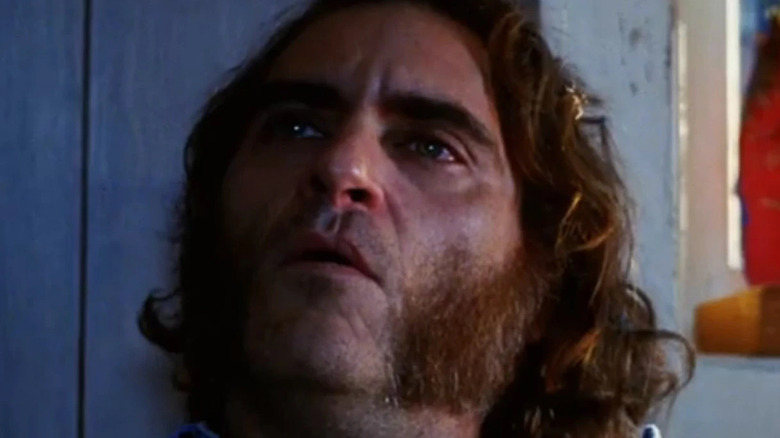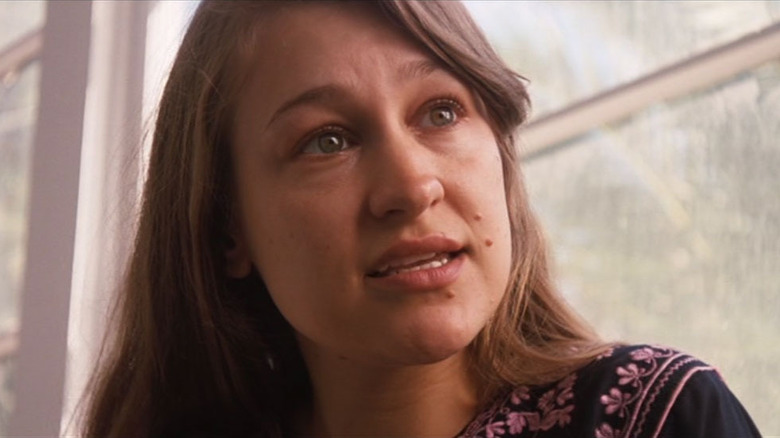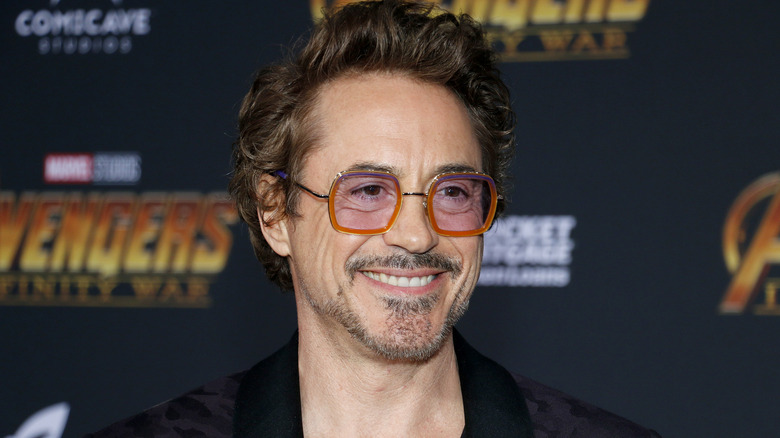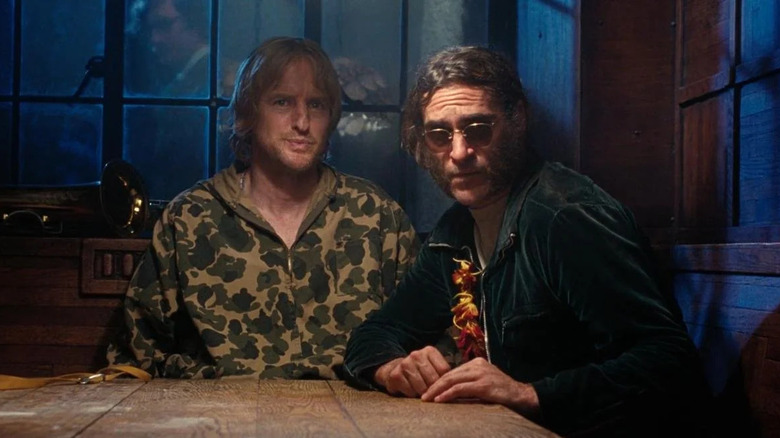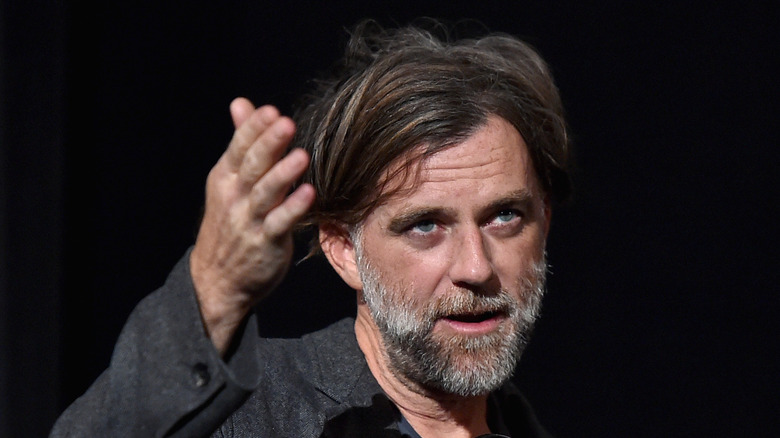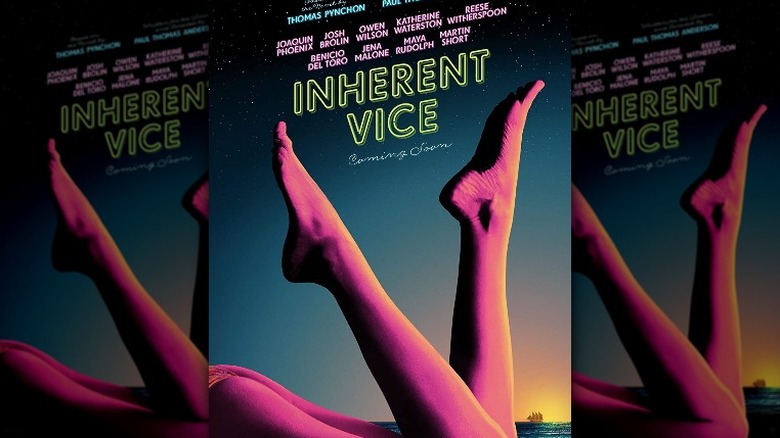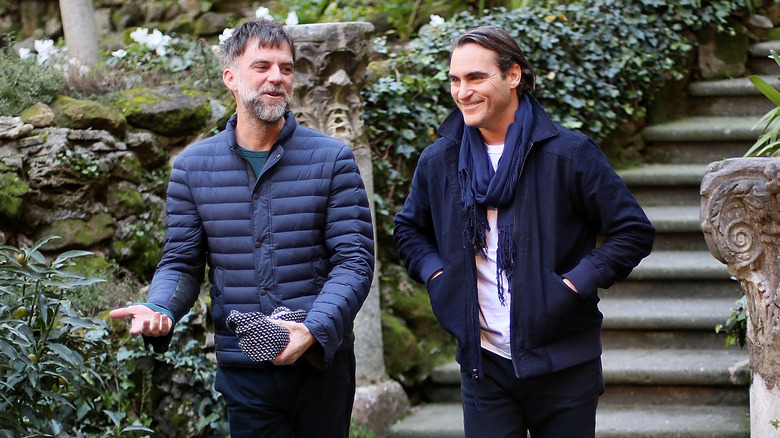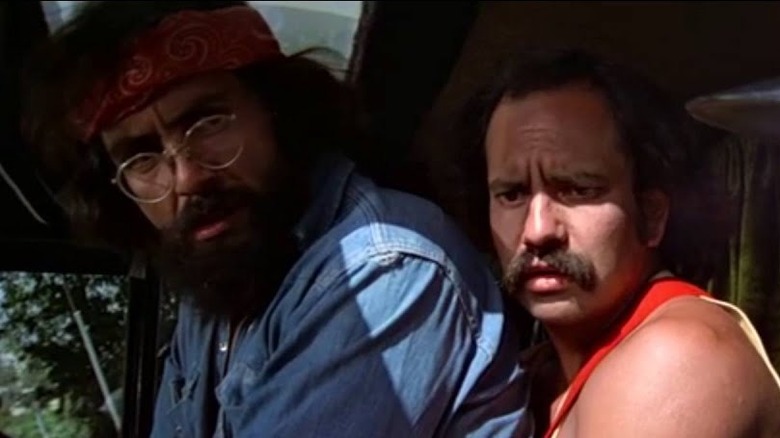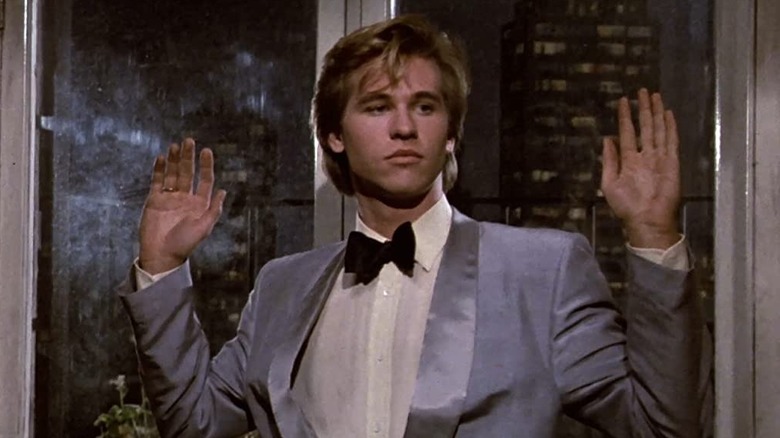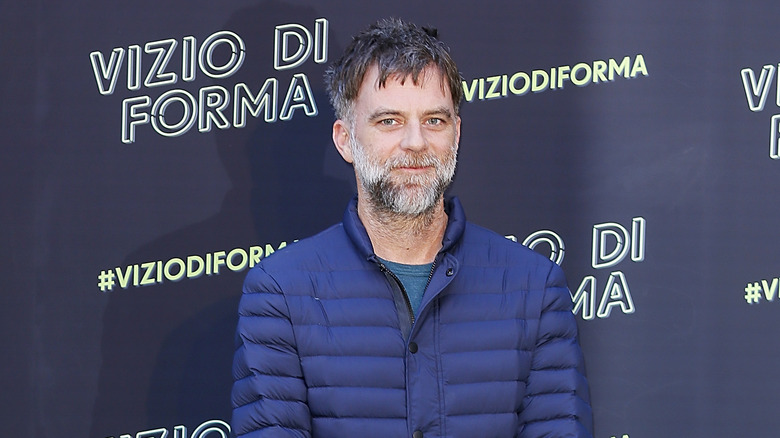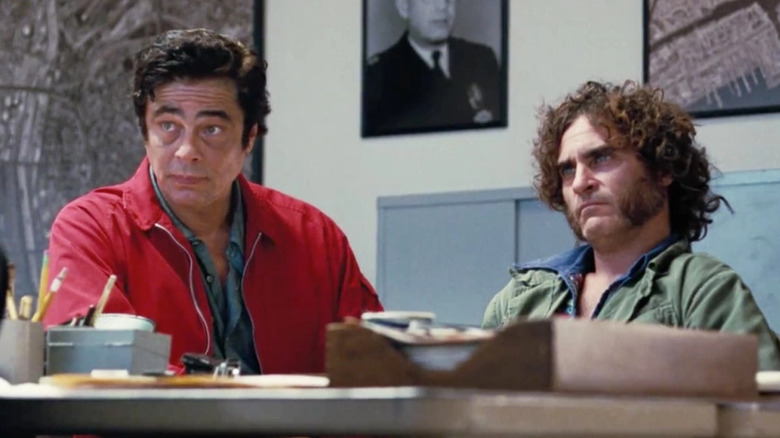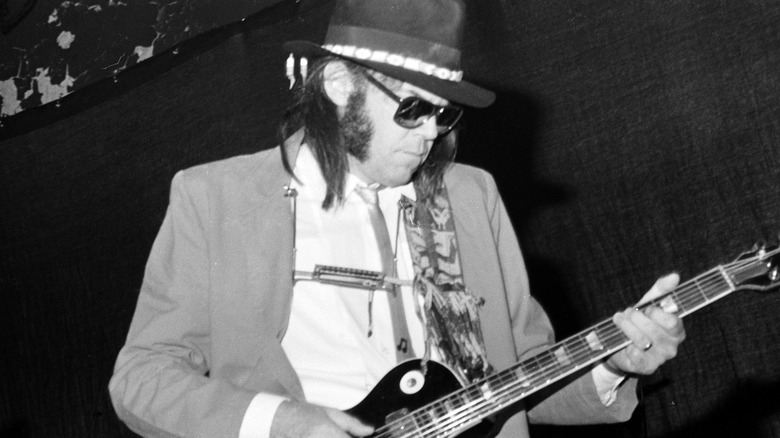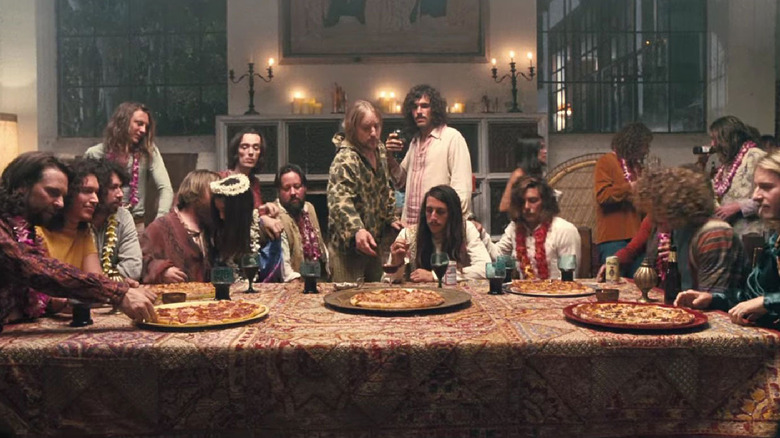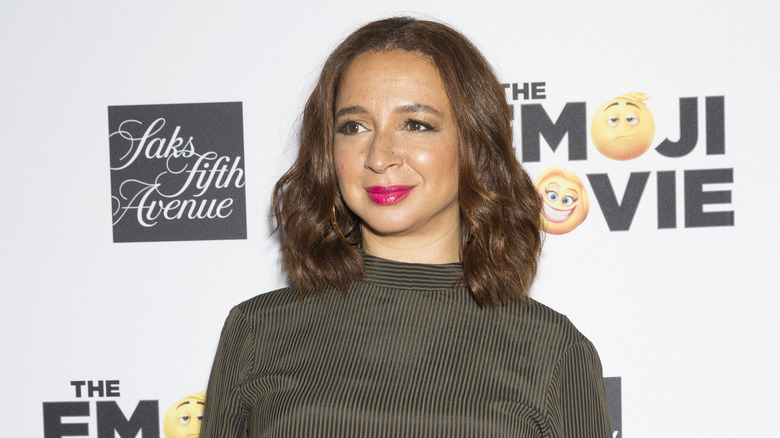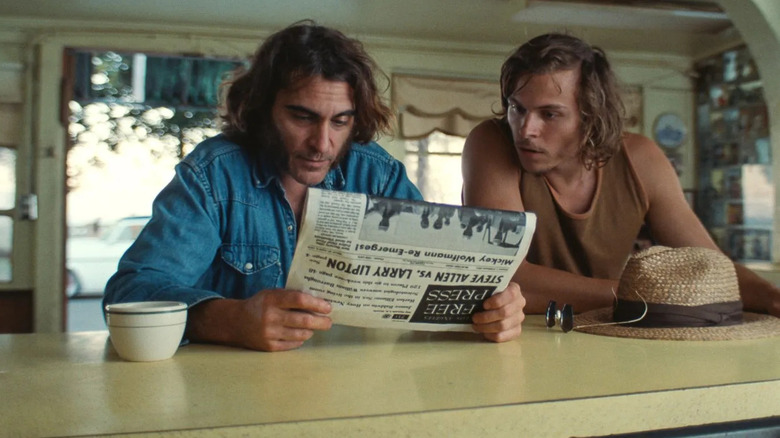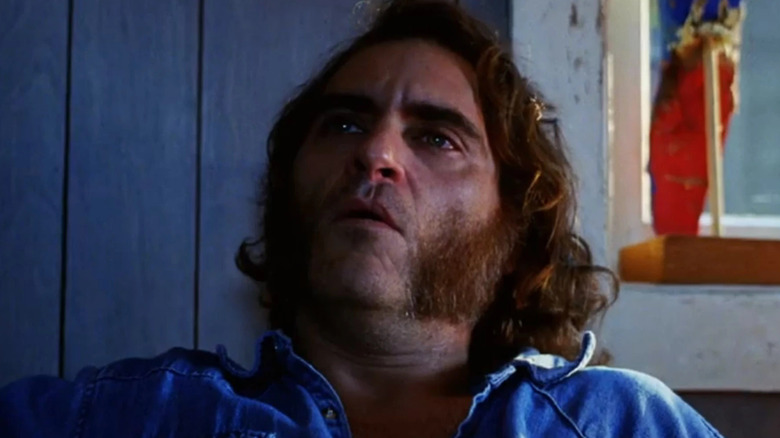The Story Of How Inherent Vice Brought Thomas Pynchon's Novel To The Big Screen
Few filmmakers have had as celebrated and diverse a filmography as Paul Thomas Anderson. Making his name in the late '90s independent film boom, Anderson quickly rose to prominence with "Boogie Nights" and "Magnolia." In the past, he's directed sprawling ensemble films, intimate character studies, and period romances. Yet, even by Anderson's standards, his 2014 film, "Inherent Vice," remains the most audacious film of his career.
Adapted from famed novelist Thomas Pynchon's book of the same name, "Inherent Vice" follows marijuana-fueled hippie private investigator Doc Sportello (Joaquin Phoenix) investigating the sudden disappearance of his ex-girlfriend (Katherine Waterston) in sunny 1970s Los Angeles. As Doc's investigation drags on, he finds himself steeped in a conspiracy involving gung-ho police officers, marine-based lawyers, drug-smuggling dentists, and a shadowy criminal group known only as the "Golden Fang."
Striking a great balance of the comedic and the melancholic, Anderson's postmodern riff on the detective story earned praise from critics who praised the movie's tone, soundtrack, ensemble cast, and faithfulness to its source material, with minor criticism aimed at the film's complex narrative. Regardless, the film garnered several awards and prestigious nominations, including an Academy Award nomination for best adapted screenplay and a best actor Golden Globe nomination for Phoenix. As lauded as the film was upon its release, there are still plenty of facts and trivia about the making of the film, including Thomas Pynchon's influence on the script and interesting details about Anderson's casting choices.
Sortilège is a minor character in the novel
As complicated as "Inherent Vice" is, a unifying link that sheds light on the movie's plot is Sortilège (Joanna Newsom). In the film, Sortilège has a dual role, serving as narrator and close friend to Shasta (Katherine Waterston) and Doc, providing occasional bits of wisdom to the latter. However, Sortilège's appearance in the movie is greatly expanded upon from the source material.
While the character is present in Thomas Pynchon's novel, Sortilège's narration was an addition made by Paul Thomas Anderson as he was writing the script. Rereading Pynchon's novel, Anderson was struck by a description of Sortilège that hints at her almost mystical ability to solve problems. "She has this all-seeing, omniscient narrator-ship character, but she doesn't reveal everything she sees or knows in her actions with her friend Doc," Newsom said to Entertainment Weekly.
As a result, Anderson expanded Sortilège's role in the film, often shooting her in such a way as to hint that she's a hallucination. Anderson feels the finished product helped capitalize on Newsom's physical presence and dreamy delivery. "[Newsom] just has that about her, that's what she brings to it just by being there. Something about her is so elegant, beautiful, and knowing. She's, like, from another planet," Anderson told Little White Lies.
Robert Downey Jr. was in talks to play Doc
"Inherent Vice" marks the second collaboration between Paul Thomas Anderson and star Joaquin Phoenix after the 2012 psychological drama, "The Master." As wonderful as Phoenix is in the role of the drug-addled, peace-loving private investigator, he wasn't the first actor considered for the role. Originally, Robert Downey Jr. was in talks with Anderson to appear in the film as Doc.
After pulling out of "Oz, the Great and Powerful," Downey began planning to take on the lead role in Anderson's adaptation of "Inherent Vice." After months of negotiations with Anderson, however, Downey ultimately decided to pass on the film. Instead, Anderson cast Joaquin Phoenix as the character. In an interview with GQ, Downey revealed that the reason for his departure was largely due to Anderson wanting someone younger for Doc. As Downey laughingly told GQ, "I think he told me I'm too old."
Thomas Pynchon may have had a cameo in the film
Before "Inherent Vice"'s release, speculation ran wild about whether the novel's notoriously reclusive author would appear in the film. Thomas Pynchon — who hasn't been officially photographed since the 1950s — is famously elusive, having dodged all media requests for interviews for well over a decade. The only instances when he's made media appearances are a brief guest role on "The Simpsons" (poking fun at his withdrawn public persona) and the audio trailer for his novel, "Inherent Vice."
Rumors circulated about Pynchon's potential role. Ahead of the film's release, Josh Brolin all but confirmed Pynchon's appearance in the film in an interview with The New York Times. According to Brolin, when it came time to film Pynchon's cameo, most of the cast and crew had no idea who he was. "He came on as the kind of mercurial iconoclast he is. He stayed in the corner," said Brolin.
Conversely, Paul Thomas Anderson remains vague on Pynchon's inclusion in the film, citing the author's desire for anonymity, while neither confirming nor denying the cameo. "Somebody spent a long time deciding not to have themselves out there. There's a reason for that. So I'm just going to step out of that," Anderson told The New York Times. However, "Inherent Vice" cast member Charley Morgan has mentioned that he asked Anderson about Pynchon being in the film, with the director telling him that the cameo doesn't exist.
Paul Thomas Anderson long considered adapting a Pynchon novel
"Inherent Vice" marks the first time a novel of Thomas Pynchon's has ever been adapted for film. It also marks the second time Paul Thomas Anderson has adapted a novel, having used Upton Sinclair's "Oil!" as the basis for his 2007 neo-Western, "There Will Be Blood." Before filming "Inherent Vice," though, Anderson expressed interest in other literary adaptations after "There Will Be Blood," even considering the possibility of adapting two other Pynchon novels for the big screen.
Anderson told The Guardian that he had briefly wrestled with the idea of producing a film based on Pynchon's 1990 novel, "Vineland," and his 1997 novel, "Mason & Dixon." However, in Anderson's words, translating such complex novels to film "would have been impossible tasks," leading the filmmaker to settle on adapting "Inherent Vice" instead.
However, Anderson, a "gigantic Pynchon fan," still made a conscious effort to pay tribute to Pynchon's previous novels in "Inherent Vice." In particular, he weaved in some smaller references to "Vineland" throughout his film, including the use of Sam Cooke's "Wonderful World," used both in the movie's trailer and again in the film's climax. "There's a kind of Pynchon nerd thing that I've done here with 'Wonderful World,'" Anderson told HuffPost. "There is a character who is very similar to Doc in 'Vineland,' and in moments of weakness, he throws on Sam Cooke. I think I remembered that intuitively."
The film's poster contains an allusion to another influential Pynchon novel
"Vineland" isn't the only novel of Pynchon's that Anderson pays homage to in "Inherent Vice." There are also several minor references to some of Pynchon's other books, some of which are very subtle. Perhaps the clearest example of this is the official poster for "Inherent Vice."
In the poster, Shasta's bare legs are kicked into the air, forming the letter "V" around the movie's title and release date. This is a reference to Pynchon's debut novel, "V.," which elevated him to literary stardom in the 1960s. Interestingly, "V." was reportedly a huge inspiration for Anderson's previous film, "The Master." As reported by Little White Lies, Pynchon's first novel has numerous ties to "The Master," including similar themes, characters, and historical settings.
"According to Newsweek, along with Pynchon's "V.," Anderson used old Navy stories he'd heard from star Jason Robards on the set of "Magnolia," unused material for "There Will Be Blood," and biographical stories about both John Steinbeck and L. Ron Hubbard as inspiration for his film.
Accounts differ on how involved Pynchon was in the production
As "Inherent Vice" is the first filmed version of a Pynchon novel, as well as the most faithful adaptation of a book Anderson has ever directed, it's worth asking how much involvement Thomas Pynchon had in the project. As with his mysterious cameo, accounts of Pynchon's involvement in the movie's production differ among the cast and crew.
In an interview with The New York Times, Joaquin Phoenix talked at length about Pynchon's influence on the movie, relating how he and Anderson would frequently engage in long conversations over the phone about the direction of the film. "It seemed like they talked often and he would make suggestions or talk about how to condense three scenes into one," said Phoenix.
However, Anderson was unsurprisingly reluctant to discuss how involved Pynchon was in the film, responding to Phoenix's claims with a good-natured, "Joaquin doesn't know what he's talking about anyway!"
Anderson used a number of classic noir stories and stoner comedies for inspiration
Given its historical setting of 1970s Los Angeles, the novel and film versions of "Inherent Vice" have a heavy basis in the detective genre and Californian surfer culture of the '60s and '70s. Consequently, "Inherent Vice" feels like a comedic mashup of '40s film noir and 1970s counterculture cinema, with Anderson likening the novel's tone to a Cheech and Chong movie.
Anderson drew inspiration from several well-known noir movies and cult classic stoner comedies. For example, Anderson has specifically mentioned films like Raymond Chandler's "The Long Goodbye" and Cheech and Chong's "Up in Smoke" as two of the movie's foremost influences. He also said that he revisited Howard Hawks' 1946 classic, "The Big Sleep," taking inspiration from the movie's complex narrative structure. "That movie made me realize that I couldn't follow any of it, and it didn't matter. That was a good model to go on, to just throw that stuff out the window," Anderson told Yahoo! Movies.
While reading the book, Anderson said that he was also struck by the similarities between Pynchon's novel and the cult neo-noir comedy, "The Big Lebowski." Rather than channeling his love for the Coen brothers' film into "Inherent Vice," Anderson says that he made a conscious effort to "pretend like ['The Big Lebowski'] didn't exist" to focus on producing his own detective romp instead.
Anderson was inspired by the wacky comedy of the Zucker brothers
One of the most remarkable aspects of Thomas Pynchon's writing is the overwhelming number of jokes and throwaway lines he incorporates into his novels. Known for his irreverent style of humor, each of Pynchon's books is brimming with eccentric characters, humorous songs, surreal scenes, and memorably ridiculous names like Pig Bodine, Oedipa Maas, and Blodgett Waxwing. With the high amount of jokes Pynchon makes in his books, the task of retaining the author's signature energetic style could be daunting for any filmmaker.
However, Anderson did his best to match Pynchon's infectiously comedic style by adding as many visual gags in the background as possible. For inspiration, Anderson says he turned to the films and TV shows of the Zucker brothers for inspiration — especially "Police Squad" and "Top Secret! —which are famous for their high volume of jokes unrelated to the main narrative. "We tried hard to imitate or rip off the Zucker brothers' style of gags so the film can feel like the book feels: just packed with stuff. And fun," Anderson told The New York Times.
The Inherent Vice party bus
To celebrate the theatrical release of "Inherent Vice,"' a very special party was organized by the Alamo Drafthouse movie theater in Denver, Colorado. Far from being a normal premiere party, the festivities were themed after the film, taking place on a bus ride through Denver. Attendees were offered the chance to eat chocolate-covered bananas (Bigfoot's snack of choice), drink Tequila Zombies (Doc and Sauncho's beverage at the dockside restaurant), and smoke recreational marijuana ahead of the film premiere. Guests also had a chance to mingle with director Paul Thomas Anderson on the way to the movie's screening at the Drafthouse.
To attend this premiere, prospective guests entered an online costume contest organized by the Alamo Drafthouse that encouraged moviegoers to post a picture of themselves in "Inherent Vice"-themed outfits on social media. Those with the best costumes earned an invitation to the Drafthouse's special bus party.
Warner Bros. released a '70s style trailer to promote the film's release
To promote the release of the film, Warner Brothers put together a special trailer that tied into the film's 1970s setting. The trailer, dubbed the "'70s Ultimate Trailer," is styled as a low-budget '70s exploitation film and contains many hallmark characteristics of grindhouse movie trailers of the era. For example, "Inherent Vice"'s trailer comes complete with a grainier quality, poor color composition, echoing audio, dated background music, and an overly dramatic voiceover delivering line after line of cheesy dialogue.
As unique a marketing tactic as this was, this would not mark the last time Warner Brothers released a special '70s-style trailer ahead of a film's release. For Shane Black's 2016 film, "The Nice Guys," the company also released a re-edited version of the film's trailer, similarly themed as though it were an actual '70s movie. Coincidentally, both films are set firmly in '70s Californian culture, depicting a hardboiled noir story against the backdrop of a swinging, drug-fueled Los Angeles.
Doc's appearance in the film is inspired by Neil Young
Set in 1970, "Inherent Vice" contains plenty of references to the decade it's based in, including a large number of hit '70s songs on the film's soundtrack. One of the foremost among these is Neil Young's 1970 song, "Journey Through the Past," which later served as the namesake for the musician's concert tour and 1973 art film, which he also directed.
Aside from Young's song, there are a few other elements that link Young to "Inherent Vice." For example, speaking at the 52nd New York Film Festival, Anderson listed Young's film version of "Journey Through the Past" as a major influence on the "look and feel" of "Inherent Vice." Also, the design for Doc's costume was taken directly from '70s photos of Neil Young.
"Inherent Vice"'s costume designer, Mark Bridges, spoke with T The New York Times Style Magazine about Young's influence on Doc's wardrobe and appearance in the film. "A lot of the DNA for Doc was Neil Young," said Bridges. Discussing Doc's costume, Bridges told MotionPictures.org, "Many times when I needed an idea for Doc I would look at Neil's choices during that era and often find a unique period look that was great then and still looks great today." Bridges also told T that he took inspiration from other contemporary musicians of the '70s as well, especially Joe Crocker.
The photo of Coy is a recreation of a famous painting
Halfway through "Inherent Vice," Doc comes across a photo of Coy (Owen Wilson) attending a party comprised chiefly of other free-spirited hippie characters gathered at a dinner table. The photo, which Doc later shows to Bigfoot to prove that Coy is still alive, is a meticulous recreation of Leonardo da Vinci's famous "The Last Supper" down to the virtually identical poses of the apostles in the original piece.
When comparing the photo of Coy with "The Last Supper," you can see Coy occupying the space near the middle of the table, roughly the same spot where Jesus sat in Leonardo da Vinci's painting. This is meant as a comedic subversion of sorts of "The Last Supper," as the scene in question comes when Doc is explaining how Coy has been "resurrected" to Bigfoot. However, it could also be interpreted as an allusion to Coy's status as a police informant — a theoretical Judas betraying his fellow hippies at the party (although Coy isn't positioned in the same place as Judas in "The Last Supper").
Anderson's real-life partner, Maya Rudolph, appears in the film
Like some of Anderson's earlier films, "Inherent Vice" utilizes a massive ensemble cast, including numerous big-name celebrities in both prominent and supporting roles. One of the more notable examples of the latter is comedian and "SNL" alumna, Maya Rudolph. In the film, Rudolph portrays Petunia Leeway, a de facto receptionist at Doc's detective agency. Rudolph is also the real-life partner of director Paul Thomas Anderson.
Anderson and Rudolph have been romantically involved since 2001, with "Inherent Vice" marking the first cinematic collaboration between the two. The couple's second and most recent creative partnership was 2021's "Licorice Pizza," which also features their four children in minor roles as well.
However, the familial connections in "Inherent Vice" run even deeper. When Rudolph's Petunia first appears, the 1969 Minnie Ripperton song, "Les Fleurs," can be heard playing in the background. Ripperton was Rudolph's mother. Maya Rudolph's father, Richard Rudolph, cowrote "Les Fleurs" with record producer Charles Stepney.
Anderson has depicted every decade of the 20th century except for one
With the release of "Inherent Vice," Anderson achieved an extremely rare feat. From his 1996 debut, "Hard Eight" to "Inherent Vice," Anderson has depicted every decade of the 20th century — save for one.
In chronological order, his 2007 film, "There Will Be Blood," took place from the late 1890s into the 1920s, with each decade shown in succession. His 2012 film, "The Master," covered the late '40s and early '50s. "Inherent Vice" contains flashbacks to the 1960s but is set in 1970. His 1997 film, "Boogie Nights," spans the golden age of pornography from the late '70s into its decline in the early '80s. Lastly, both "Hard Eight" and Anderson's 1999 epic, "Magnolia," are set in the 1990s.
With the exception of the 1930s, Anderson has covered every decade of the 20th century in his filmography. Following "Inherent Vice," he returned to the 1950s with his 2017 gothic romance, "Phantom Thread" and went back to the '70s with his coming-of-age comedy, "Licorice Pizza." He also depicted the first years of the 2000s with his 2002 romantic comedy, "Punch-Drunk Love."
There are several close parallels between Doc and Bigfoot
During a climactic scene in "Inherent Vice," Doc and Bigfoot have a tender moment in which they try to apologize to each other for their past antagonistic relationship. Strangely, both men end up saying the same thing at the same time. As bizarre as the incident is, this is not the first time Doc and Bigfoot unconsciously mimic each other.
Earlier in the film, the two detectives share several phone calls, mirroring each other's movements, body language, and actions. For example, when Doc takes a moment to smoke marijuana in the middle of their conversation, Bigfoot takes a sip from his glass of whiskey. Later, after Shasta returns to Doc's home, both men talk on the phone as their respective romantic partners intermittently walk by in the background. Additionally, both men have the same light green phone.
All of this is likely meant to foreshadow their cathartic conversation at the end of the film. It's also, of course, meant as a way to illustrate that, for all their differences, they share many similarities without even realizing it.
